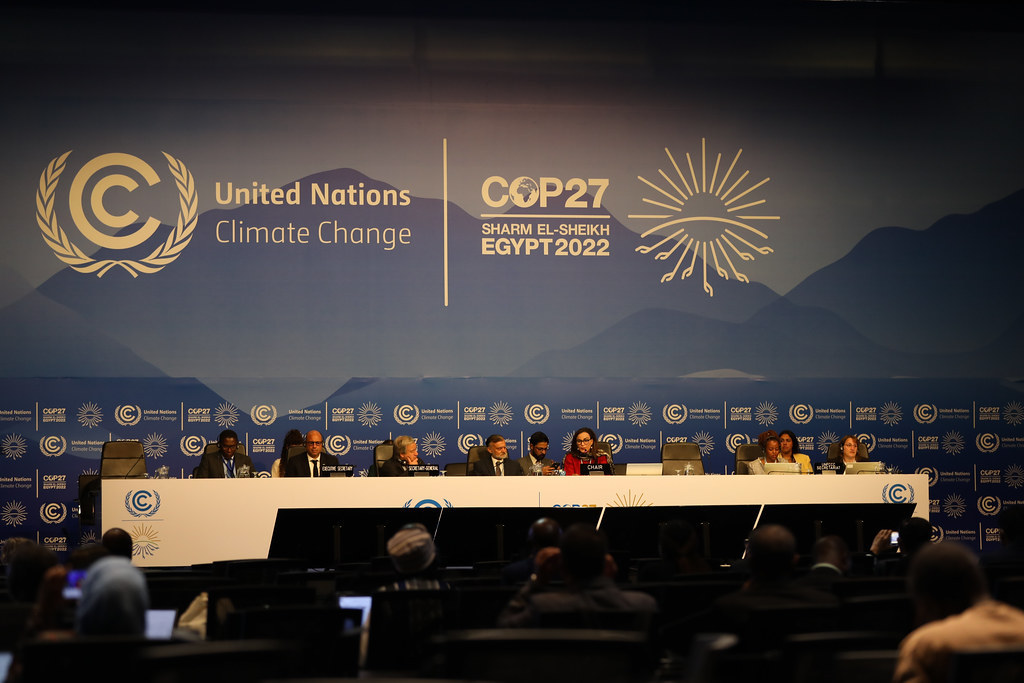COP27 was held in Sharm-El-Sheikh, Egypt from Nov. 6-18 as an opportunity for leaders from around the world to build on past climate change momentum and deliver on the goals set out by the Paris Agreement. This yearly UN climate change conference attempts to work towards keeping global temperature increase to less than 1.5℃, reducing emissions, and funding climate change solutions around the world.
This year in particular, the conference was promoted as being heavily centered around implementation and progress coming off of the last conference in Glasgow. However, many are critical of this perception, arguing that world leaders still aren’t doing enough to reach these ambitious climate goals. So to break down this confusion and conflict further, here are some of the biggest takeaways from the conference:
1. Loss and Damage, and the Different Roles of Developed and Developing Nations
The most prominent topic of discussion at the conference was the idea of loss and damage. This concept deals with how developing countries are disproportionately impacted by the climate crisis despite contributing the lowest amount of emissions and waste, while developed countries face minimal consequences yet pollute the most. To rectify this, many countries have proposed reparations of sorts to have developed countries pay compensation for these losses and damage.
Gabon’s environmental minister was quoted before COP27 saying, “Over and over again, developed nations have committed and not delivered. They’ve committed to reduce emissions and they’re not delivering sufficiently. They’ve committed to funding and that funding doesn’t ever seem to materialize. We didn’t create the problem and so you would expect a more sincere engagement from developed nations and you would expect them to respect their word and their engagements.” This sentiment succinctly summarizes the attitude of many of the developing nations at COP27 who feel a sense of mistrust and betrayal from developed nations.
This topic was so contentious that discussions of funding for nations who have faced environmental disasters pushed the conference past its deadline and left deal-making in a rocky position. The EU set forth the main proposal for this issue, but tied it to another contentious point in the conference: cutting emissions.
The EU’s proposal is to tie in aggressively slashing emissions with creating a pool of money for relief for poorer countries. To underscore the need for such a two pronged policy, Germany’s Foreign Minister, Annalena Baerbock, said, “no money in the world could pay for the damages and losses of the future”.
Before the EU’s proposal, the main options for the loss and damage issue were to establish a new fund this year or push off all discussion of a fund until next year. While establishing a fund this year without tying in accountability and emission reduction would likely fall short of delivering true climate justice, developing nations urged the conference to come to a decision about establishing a fund this year; they feel as though waiting until next year would be too little, too late as the frequency and severity of environmental disasters is only increasing. While the EU has led the charge for developed nations on promoting this emission reduction bound fund pool, the U.S. has remained largely silent stalling deal-making further.
Ultimately, after all-night negotiations and contentious debate, a deal was finally reached marking a monumental and historic step towards greater climate equity and reparations. While many, like the EU, argue the deal doesn’t go far enough, necessary consensus was reached to establish a global loss and damages fund.
With vague language on limiting fossil fuel use and keeping to the 1.5℃ warming, the difficult work is only just beginning. The bulk of the logistics and financials of the fund yet to be determined. Nevertheless, this deal marks a big step towards climate justice for the most vulnerable nations. However, in order to reach true equity, post-conference accountability of developed nations and more unified, substantive progress towards reducing emissions will be critical.
2. Greenwashing: Preventing it or Exhibiting it at COP27?
Another topic which was on full display at the conference was the idea of greenwashing. Greenwashing is the phenomenon of countries or companies making wide-sweeping claims about their sustainability without actually delivering true, tangible climate focused action.
Countries at the conference came down hard on companies who are attempting to reach “net zero” carbon emissions by a specified date. This is an example of greenwashing because companies can continue to pollute at the same levels while increasing their carbon offsets by planting trees or investing in carbon removal technologies.
Despite this harsh criticism, outsiders and climate activists are accusing COP27 as a whole of being an example of greenwashing. Because this conference was supposed to be centered around implementation but has largely fallen short with stalled deal-making and lackluster commitments to the goals set out by the Paris Agreement by the largest polluters, many are viewing the conference as yet another example of greenwashing and performative activism.
Greta Thunberg, one of the youngest but most prominent leaders of the environmental movement, stated she would not attend COP27 arguing that, “The COPs are mainly used as an opportunity for leaders and people in power to get attention, using many different kinds of greenwashing”.
Further, the conference drew a lot of criticism from environmentalists for having Coca-Cola as a sponsor of the event since they are one of the largest producers of plastic worldwide. Coca-Cola is one of the very companies that engages in the greenwashing strategy previously outlined of pledging to reach net zero without cutting ties with fossil fuels. This commitment to denouncing these companies and their misleading tactics but simultaneously allowing them to sponsor the event adds to this mixed messaging.
Coca-Cola wasn’t the only fossil fuel linked group to have a presence at COP27. In fact, over 636 COP27 attendees have direct links to the fossil fuel industry. This is a 25% increase in fossil fuel representatives from last year’s conference, and these 636 fossil fuel representatives outnumber the total number of combined representatives from the 10 most climate impacted nations.
It is clear that change is needed dramatically and quickly in order to adequately address the climate crisis. These issues and whether or not this change can come from a COP27-style conference is likely to be one of the major talking points that the world must grapple with after the conclusion of this conference.
3. Unreported and Misreported Emissions
An environmental NGO called Climate TRACE, which tracks emissions, reported that oil and gas companies could be underreporting their emissions. Through analysis of 72,612 CO2 sources, Climate TRACE found that unreported, actual emissions could be three times higher than reported levels.
Oil and gas fields consistently ranked highest in terms of largest polluters, and the United States’ Permian Basin — an oil and gas field — was reported to be the largest source of CO2 emissions worldwide.
This misleading reporting and lack of data further compounds the inability of individuals and grassroots groups to adequately address the climate crisis. So much of the real data has been obscured by major corporations for decades. Demands for both more transparency from corporations but also more independent research and oversight are likely to be a focal point for discussions after the conference.
4. Extreme Weather and “Adapting” to Climate Change
COP27 was held against the backdrop of some of the worst natural disasters and extreme weather events of recent memory. From extreme flooding in Pakistan to uncharacteristic drought in Europe, the world has faced extreme challenges from the consequences of climate change over the past year.
The traditional climate change response has been one of mitigation. Mitigation in climate change policy and advocacy is action taken to prevent further environmental damage or future disasters. Mitigation is also typically a more national and international response to climate change.
However, as these climate disasters worsen and occur with more frequency, local and state governments are left with the difficult and costly task of dealing with them at the present. To face this reality, COP27 featured a greater discussion around adaptation rather than mitigation. Adaptation is the approach of adjusting to and preparing for these disasters because they are more or less inevitable. Essentially, adaptation is more of a harm reduction and risk minimization approach.
While adaptation certainly deserves discussion and can play a critical role in the global response to climate change, it undoubtedly has its limitations. The limitations of adaptation were another key talking point at the conference with scientists warning that humans cannot adapt to all effects of climate change and that we must put mitigation at the forefront with adaptation as a supplement.
These same scientists urged nations to continue the discussion of loss and damage, because this compensation will be necessary since the world cannot adapt infinitely. Clearly, this underscores the importance of loss and damage as a critical theme of the conference, but adaptation is a reality that also must be addressed.
Nonetheless, progress was made on the Global Goal on Adaptation, with added funds and an end goal of the first Global Stockade at COP28. These measures will add resiliency to the most vulnerable nations. The next step is further funding for adaptation combined with renewed, substantial progress towards mitigation policies as vital components of an equitable and sustainable global response to climate change.
5. The Effects of the War in Ukraine
Along with the increased extreme natural disasters, COP27 discussions were also impacted by the war in Ukraine. Since Russia is such a large producer of oil and gas, the war in Ukraine inevitably drove up oil and gas prices. One idea that was promoted by Gaston Browne, the prime minister of Antigua and Barbuda, was to tax global corporations who are profiting from this increase in price resulting from the war.
However, this proposal was not universally well received with German chancellor Olaf Scholz arguing that COP27 is not the forum for tax discussion but rather climate change mitigation strategies. Scholz has truly felt this increased pressure on his country’s energy supply as earlier this year he ordered Germany’s three remaining nuclear power plants to keep running to offset Germany’s loss of energy from Russia.
Similarly, other countries like China have returned to relying on coal fired power plants which are the largest greenhouse gas polluters in response to the increase in price and decrease of supply from Russia. Coming out of this conference, global leaders are going to have to grapple with building emergency response plans and renewable energy grids for their countries; they must be substantial enough to avoid resorting back toward fossil fuels in this way when emergency and disaster strikes. To truly switch to a renewably powered world, being sustainable under the optimal conditions is not enough. The renewable energy grid must be able to support fluctuations in demand for other energy sources as well.







